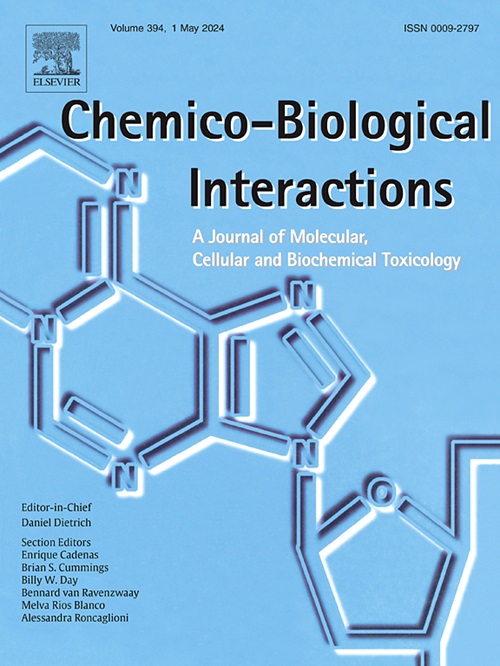An in vitro evaluation on metabolism of mitragynine to 9-O-demethylmitragynine
IF 4.7
2区 医学
Q1 BIOCHEMISTRY & MOLECULAR BIOLOGY
引用次数: 0
Abstract
Kratom (Mitragyna Speciosa Korth.) is an indigenous tree native to Southeast Asia whose leaves have been traditionally ingested as a tea and has seen its popularity increase in the United States. Although kratom and its constituents presently have no approved uses by the Food and Drug Administration, its major alkaloids (e.g., mitragynine) have psychoactive properties that may hold promise for the treatment of opioid cessation, pain management, and other indications. 9-O-demethylmitragynine is a major metabolite formed from mitragynine metabolism (36 % total metabolism) and displays similar pharmacologic activity. Cytochrome P450 (CYP) 3A4 has been identified as a major enzyme involved in mitragynine metabolism; however, the in vitro metabolism parameters of 9-O-demethylmitragynine formation are not well defined and a risk of potential drug interactions exists. Using human liver S9 fractions, 9-O-demethylmitragynine formation was generally linear for enzyme concentrations of 0–0.25 mg/mL and incubation times of 5–20 min. 9-O-demethylmitragynine displayed a Km 1.37 μM and Vmax of 0.0931 nmol/min/mg protein. Known CYP inhibitors and compounds that might be concomitantly used with kratom were assessed for inhibition of 9-O-demethylmitragynine formation. Ketoconazole, a CYP3A index inhibitor, demonstrated a significant effect on 9-O-demethylmitragynine formation, further implicating CYP3A4 as a major metabolic pathway. Major cannabinoids (10 μg/mL) displayed minor inhibition of 9-O-demethylmitragynine formation, while all other compounds had minimal effects. Mixtures of physiological achievable cannabinoid concentrations also displayed minor effects on 9-O-demethylmitragynine formation, making a metabolic drug interaction unlikely; however, further in vitro, in vivo, and clinical studies are necessary to fully exclude any risk.
体外评估丝氨酸代谢为 9-O-demethylmitragynine 的情况。
桔梗(Mitragyna Speciosa Korth.)是一种原产于东南亚的本土树种,其叶子历来被当作茶叶饮用,在美国越来越受欢迎。虽然目前美国食品和药物管理局还没有批准 kratom 及其成分的用途,但其主要生物碱(如米曲金宁)具有精神活性特性,可能有望用于治疗阿片类药物戒断、疼痛控制和其他适应症。9-O-demethylmitragynine 是丝氨酸代谢过程中形成的一种主要代谢物(占代谢总量的 36%),具有类似的药理活性。细胞色素 P450 (CYP) 3A 已被确定为参与米屈肼代谢的主要酶;然而,9-O-去甲米屈肼形成的体外代谢参数尚未明确,存在潜在药物相互作用的风险。利用人体肝脏 S9 馏分,在酶浓度为 0 至 0.25 毫克/毫升、孵育时间为 5 至 20 分钟的情况下,9-O-去甲基米拉宁的形成一般呈线性关系。9-O-去甲基米拉宁的 Km 值为 1.37 μM,Vmax 值为 0.0931 毫摩尔/分钟/毫克蛋白质。评估了已知的 CYP 抑制剂和可能与桔梗同时使用的化合物对 9-O-demethylmitragynine 生成的抑制作用。酮康唑是一种强效的 CYP3A 抑制剂,对 9-O-去甲基米拉基宁的形成有显著影响,进一步表明 CYP3A 是一种主要的代谢途径。主要大麻素(10 微克/毫升)对 9-O-demethylmitragynine 的形成有轻微的抑制作用,而所有其他化合物的影响都很小。生理上可达到的大麻素浓度的混合物对 9-O-去甲米升麻宁的形成也有轻微影响,因此不太可能发生药物代谢相互作用;不过,要完全排除任何风险,还需要进一步的体外、体内和临床研究。
本文章由计算机程序翻译,如有差异,请以英文原文为准。
求助全文
约1分钟内获得全文
求助全文
来源期刊
CiteScore
7.70
自引率
3.90%
发文量
410
审稿时长
36 days
期刊介绍:
Chemico-Biological Interactions publishes research reports and review articles that examine the molecular, cellular, and/or biochemical basis of toxicologically relevant outcomes. Special emphasis is placed on toxicological mechanisms associated with interactions between chemicals and biological systems. Outcomes may include all traditional endpoints caused by synthetic or naturally occurring chemicals, both in vivo and in vitro. Endpoints of interest include, but are not limited to carcinogenesis, mutagenesis, respiratory toxicology, neurotoxicology, reproductive and developmental toxicology, and immunotoxicology.

 求助内容:
求助内容: 应助结果提醒方式:
应助结果提醒方式:


